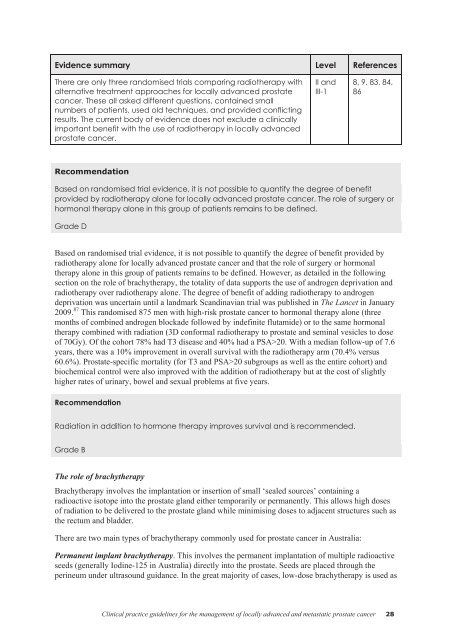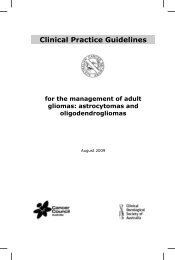Clinical Practice Guidelines for the management of locally advanced ...
Clinical Practice Guidelines for the management of locally advanced ...
Clinical Practice Guidelines for the management of locally advanced ...
Create successful ePaper yourself
Turn your PDF publications into a flip-book with our unique Google optimized e-Paper software.
Evidence summary Level References<br />
There are only three randomised trials comparing radio<strong>the</strong>rapy with<br />
alternative treatment approaches <strong>for</strong> <strong>locally</strong> <strong>advanced</strong> prostate<br />
cancer. These all asked different questions, contained small<br />
numbers <strong>of</strong> patients, used old techniques, and provided conflicting<br />
results. The current body <strong>of</strong> evidence does not exclude a clinically<br />
important benefit with <strong>the</strong> use <strong>of</strong> radio<strong>the</strong>rapy in <strong>locally</strong> <strong>advanced</strong><br />
prostate cancer.<br />
Recommendation<br />
II and<br />
III-1<br />
8, 9, 83, 84,<br />
86<br />
Based on randomised trial evidence, it is not possible to quantify <strong>the</strong> degree <strong>of</strong> benefit<br />
provided by radio<strong>the</strong>rapy alone <strong>for</strong> <strong>locally</strong> <strong>advanced</strong> prostate cancer. The role <strong>of</strong> surgery or<br />
hormonal <strong>the</strong>rapy alone in this group <strong>of</strong> patients remains to be defined.<br />
Grade D<br />
Based on randomised trial evidence, it is not possible to quantify <strong>the</strong> degree <strong>of</strong> benefit provided by<br />
radio<strong>the</strong>rapy alone <strong>for</strong> <strong>locally</strong> <strong>advanced</strong> prostate cancer and that <strong>the</strong> role <strong>of</strong> surgery or hormonal<br />
<strong>the</strong>rapy alone in this group <strong>of</strong> patients remains to be defined. However, as detailed in <strong>the</strong> following<br />
section on <strong>the</strong> role <strong>of</strong> brachy<strong>the</strong>rapy, <strong>the</strong> totality <strong>of</strong> data supports <strong>the</strong> use <strong>of</strong> androgen deprivation and<br />
radio<strong>the</strong>rapy over radio<strong>the</strong>rapy alone. The degree <strong>of</strong> benefit <strong>of</strong> adding radio<strong>the</strong>rapy to androgen<br />
deprivation was uncertain until a landmark Scandinavian trial was published in The Lancet in January<br />
2009. 87 This randomised 875 men with high-risk prostate cancer to hormonal <strong>the</strong>rapy alone (three<br />
months <strong>of</strong> combined androgen blockade followed by indefinite flutamide) or to <strong>the</strong> same hormonal<br />
<strong>the</strong>rapy combined with radiation (3D con<strong>for</strong>mal radio<strong>the</strong>rapy to prostate and seminal vesicles to dose<br />
<strong>of</strong> 70Gy). Of <strong>the</strong> cohort 78% had T3 disease and 40% had a PSA>20. With a median follow-up <strong>of</strong> 7.6<br />
years, <strong>the</strong>re was a 10% improvement in overall survival with <strong>the</strong> radio<strong>the</strong>rapy arm (70.4% versus<br />
60.6%). Prostate-specific mortality (<strong>for</strong> T3 and PSA>20 subgroups as well as <strong>the</strong> entire cohort) and<br />
biochemical control were also improved with <strong>the</strong> addition <strong>of</strong> radio<strong>the</strong>rapy but at <strong>the</strong> cost <strong>of</strong> slightly<br />
higher rates <strong>of</strong> urinary, bowel and sexual problems at five years.<br />
Recommendation<br />
Radiation in addition to hormone <strong>the</strong>rapy improves survival and is recommended.<br />
Grade B<br />
The role <strong>of</strong> brachy<strong>the</strong>rapy<br />
Brachy<strong>the</strong>rapy involves <strong>the</strong> implantation or insertion <strong>of</strong> small ‘sealed sources’ containing a<br />
radioactive isotope into <strong>the</strong> prostate gland ei<strong>the</strong>r temporarily or permanently. This allows high doses<br />
<strong>of</strong> radiation to be delivered to <strong>the</strong> prostate gland while minimising doses to adjacent structures such as<br />
<strong>the</strong> rectum and bladder.<br />
There are two main types <strong>of</strong> brachy<strong>the</strong>rapy commonly used <strong>for</strong> prostate cancer in Australia:<br />
Permanent implant brachy<strong>the</strong>rapy. This involves <strong>the</strong> permanent implantation <strong>of</strong> multiple radioactive<br />
seeds (generally Iodine-125 in Australia) directly into <strong>the</strong> prostate. Seeds are placed through <strong>the</strong><br />
perineum under ultrasound guidance. In <strong>the</strong> great majority <strong>of</strong> cases, low-dose brachy<strong>the</strong>rapy is used as<br />
<strong>Clinical</strong> practice guidelines <strong>for</strong> <strong>the</strong> <strong>management</strong> <strong>of</strong> <strong>locally</strong> <strong>advanced</strong> and metastatic prostate cancer<br />
28



